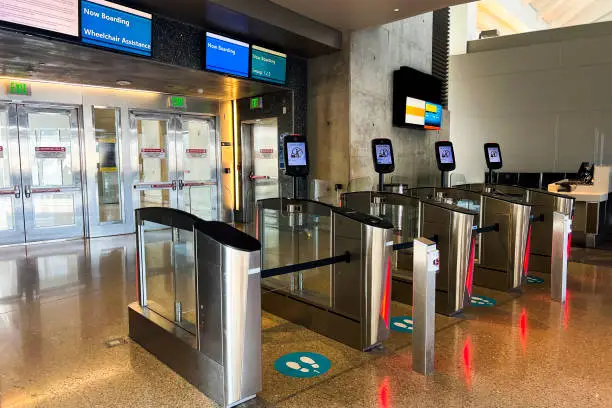
How Technology is Transforming Airport Security
The airport security market refers to the systems, technologies, and services used to protect airports, aircraft, and passengers from threats like terrorism, accidents, and crime. It is a crucial part of the aviation industry and ensures the safety of millions of travelers worldwide.
The global airport security market was valued at USD 10.74 billion in 2021. It is expected to expand at a compound annual growth rate (CAGR) of 7.3% from 2022 to 2030. Several factors are driving growth in this market, including:
-
Increased security regulations – Governments globally have implemented stricter security protocols at airports following major incidents of terrorism. Mandating advanced systems has become key for airport security.
-
Rising air traffic and new airports – The expansion of the aviation industry itself fuels further growth of the airport security market. More passengers and aircraft to be screened raise demand for security systems. According to IATA, air passenger numbers are expected to double to 8.2 billion in 2037.
-
Technological developments – New sophisticated systems like biometric screening and AI-based scanners are transforming airport security. Their adoption is increasing to enhance their threat detection capabilities.
-
Infrastructure investments – Many aging airports, especially in developing economies, are undergoing large-scale renovations and requiring upgrades to their security systems.
The airport security market is witnessing high growth. Continued innovation in this space towards automation, digitalization, and minimal human involvement will shape its future outlook.
Market Drivers
The airport security market is driven by several key factors, such as increasing passenger traffic, new airport construction projects, and technological advancements.
-
Increasing passenger traffic – The global aviation industry has seen tremendous growth in passenger traffic in recent years. According to IATA, global passenger traffic increased by 6.5% in 2017 compared to 2016. The growth is being fueled by both developing economies as well as mature aviation markets. The rise in passenger traffic is leading to increased security requirements at airports. Airports are upgrading their security systems and protocols to handle larger crowds and ensure passenger safety.
-
New airport construction projects – With air passenger growth outpacing available airport capacity, there is a boom in new airport construction projects globally. According to the CAPA Centre for Aviation, there are over 200 new airports or terminal projects underway. Large new projects like Beijing Daxing International Airport and Istanbul New Airport have comprehensive security infrastructure plans. Additionally, upgrades at existing airports also drive demand for new security technologies and systems.
-
Technological advancements – The airport security technology market is evolving rapidly with new innovations focused on greater accuracy, speed, and ease of use. Advanced X-ray scanners, explosive trace detectors, biometric systems, and AI-based threat monitoring systems are some areas seeing focused R&D activity. Airport operators are keen to adopt smarter security technologies to enhance both security and passenger experience.
Screening Systems
Airport security screening systems are used to detect prohibited items and contraband being brought onto aircraft or restricted areas. Key types of screening systems include:
-
Passenger screening – Technologies like walk-through metal detectors, full body scanners, explosive trace detection systems, and advanced imaging technology are used to screen passengers and their carry-on luggage before entering the airport terminal or boarding the aircraft. This ensures no prohibited items like weapons or explosives are brought onboard. Advanced systems use 3D imaging, millimeter waves, and automated threat recognition software for more effective passenger screening.
-
Baggage screening – Checked luggage goes through X-ray machines and CT scanners to identify dangerous objects and materials inside bags. Explosive detection systems (EDS) use computed tomography to automatically recognize explosives. Some airports also use inline baggage screening systems during baggage handling to streamline security.
-
Cargo screening – Cargo and freight shipped by air must also undergo screening. Techniques like X-ray scanning, explosive detection systems, and canine teams trained to sniff out explosives are used to inspect cargo for threats. 100% screening of all cargo on passenger flights is required by many countries.
Investments in next-generation screening technologies along with stringent security regulations are key drivers propelling the growth of the airport security screening systems market worldwide.
Access Control
Access control systems are critical for airport security to monitor and restrict access to restricted areas. This includes technologies like perimeter intrusion detection, video surveillance, and barriers.
Perimeter intrusion detection systems use radars, sensors, and cameras to detect any unauthorized access into restricted zones. These systems can differentiate between animals, debris, or actual security breaches. Some airports also use active infrared beams that can detect when the beam is broken.
Video surveillance technology allows airport security to visually monitor airport terminals, hangars, runways, and other sensitive areas. High-definition cameras provide detailed video footage that can be analyzed using video analytics software. Surveillance footage is stored and recorded for incident investigation purposes.
Physical barriers and bollards are used to create chokepoints and deny vehicle access near terminals. Retractable road blockers allow authorized vehicles to pass during permitted times. Crash-rated active vehicle barriers are used at airport perimeters and near buildings. Interlocking metal barriers make it difficult to force through checkpoints.
Access control combines various systems to restrict and control access to sensitive airport areas. Advanced integration and analytics of access control systems are crucial for airport security.
Services
The airport security market offers various services to help airports and airlines enhance safety and security. Key services in this market include:
Managed Services
Managed services provide outsourced management and operation of airport security systems and processes. This allows airports to benefit from expert resources and advanced technologies without large upfront investments. Managed services may include areas like passenger screening, baggage handling, video surveillance, access control, and cybersecurity. Top providers have extensive aviation experience to deliver reliable and efficient security services tailored to an airport’s specific needs.
Training Services
Training services equip airport staff and security personnel with the skills needed to operate security systems, follow protocols, and respond to incidents. As regulations and technologies frequently update in the airport security sector, ongoing training is essential. Leading training providers have experience developing programs aligned with regulatory requirements. Courses may cover areas like checkpoint screening, baggage inspection, incident response, and more.
Installation & Integration
These services handle the deployment, configuration and integration of new security systems and equipment. Airport security requires the complex integration of various technologies like X-ray scanners, metal detectors, biometric readers, video surveillance and more. Professional installation and integration ensure systems are properly networked, calibrated, and tested before going live. Ongoing support services are also offered for maintenance, upgrades, and expansions.
Technologies
The airport security market is rapidly adopting new technologies to enhance efficiency and improve the passenger experience. Some of the key technologies shaping this industry include:
Biometrics
Facial recognition, iris scanning, and fingerprint matching are becoming commonplace at airport security checkpoints. Biometrics provides a touchless and automated way to verify passenger identities and streamline processes. Major players like Clear and CLEAR Me are using biometrics for expedited screening. Integrating biometrics into e-gates also enables automated border checks.
Artificial Intelligence
AI algorithms are being deployed for automated threat detection in X-ray scans of baggage. Machine learning models can flag suspicious items or anomalies for further inspection. AI is also powering chatbots and virtual assistants to provide customer service and travel information to passengers. Looking ahead, AI could be used for behavior analysis to identify potential security threats.
Advanced Screening Systems
New sophisticated screening tools provide detailed 3D imagery of baggage contents, reducing the need for manual bag searches. Millimeter wave scanners offer high-resolution body scans to detect concealed objects without physical contact. Backscatter X-ray scanners bounce X-rays off a person’s body to uncover hidden items. These technologies enhance threat detection while improving the screening experience.
Sensor Fusion
Combining data from a network of sensors provides deeper insights than a single sensor alone. CCTV surveillance paired with acoustic sensors, infrared cameras, and radar can better analyze events and improve threat response. Integrating multiple detection technologies creates a more accurate and reliable airport security ecosystem.
Cybersecurity
With airports becoming highly connected environments, securing networks, data centers, and equipment against cyber risks is critical. Airport security systems must embed cybersecurity best practices like encryption, access controls, and vulnerability testing. Robust cybersecurity safeguards airports against sabotage, data breaches, and operational disruptions.
Embracing advanced technologies along with vigilance and training helps maximize airport security while maintaining privacy and facilitating air travel. Integrating biometrics, AI, sophisticated screening, sensor fusion, and cybersecurity solutions will define the future of the airport security market.
Key Players
The airport security market is highly fragmented, with several companies competing for market share. Some of the major players in this market include:
L3 Security & Detection Systems
- One of the top companies in airport security, offering x-ray scanning systems, explosive detection systems, metal detectors, and more. Has a significant market share in the US and Europe.
Smiths Detection Group Ltd.
- Leading supplier of threat detection and screening technologies for aviation security. Provides X-ray scanners, explosives trace detectors, and computed tomography scanners. Holds around 30% global market share.
OSI Systems, Inc.
- A major provider of security inspection systems and services for homeland security markets. Supplies X-ray and radioactive threat detection equipment to airports worldwide. Estimated to account for 15% of the global market.
Siemens AG
- Multinational conglomerate with a large presence in airport security through subsidiary Siemens Logistics. Provides automated access control systems, video analytics, fire safety, and other solutions.
American Science and Engineering
- A key player in cargo, parcel, and personnel inspection systems. Leading supplier of X-ray detection systems to airports and customs agencies. Has around 10% market share.
Analogic Corporation
- Specializes in CT scanners, explosives detection systems, and medical imaging equipment. Its airport security division is a top supplier of checkpoint CT scanners.
The market concentration is expected to increase through mergers and acquisitions as companies compete for larger shares of the expanding global airport security market.
Regional Analysis
North America
North America is expected to account for the largest share in the airport security market. The growth in this region can be attributed to the presence of major players providing airport security solutions, increased government spending on airport infrastructure and security, and early adoption of new technologies like AI, ML and biometrics. The US accounts for the maximum share in the North American market due to high air passenger traffic and government initiatives to modernize airport security systems.
Europe
Europe is the second largest region in the airport security market. The rising number of terror threats and increasing cases of cybercrime have compelled European countries to enhance security at airports. Government mandates like the European Programme for Critical Infrastructure Protection have also boosted the adoption of new technologies and security solutions in the region. The UK, Germany, France, and Italy are major markets in Europe.
Asia Pacific
The Asia Pacific airport security market is expected to grow at the highest CAGR during the forecast period. Factors like increasing air passenger traffic, development of new airports, and modernization of existing airports are driving the demand for airport security solutions in this region. China, Japan, India, South Korea, and Singapore are key countries contributing to the growth in Asia Pacific.
Middle East & Africa
The Middle East & Africa presents significant growth opportunities in the airport security market mainly due to increasing investments to build new airports and upgrade existing ones. The growing number of passengers and cargo flights also supports the adoption of advanced security technologies at airports. UAE and Saudi Arabia are major markets in this region.
Latin America
Latin America is expected to witness the second-highest CAGR after Asia Pacific. Brazil and Mexico are the largest aviation markets in the Latin American region. Large investments in enhancing airport capacity and infrastructure are among the key factors fueling the adoption of airport security solutions in Latin American countries.
Regulations
With air travel rising globally each year, several regulations have been implemented to enhance airport security. These regulations aim to detect threats while balancing efficiency and passenger experience.
The key regulations agency in the United States is the Transportation Security Administration (TSA), which oversees all transportation security including airports. Following the 9/11 attacks, the TSA created and implemented new screening requirements for all checked baggage. Regulations have progressively been tightened by the TSA over the years to improve security effectiveness. Key regulations include:
- Mandatory screening of all passengers and baggage
- Banning of certain items in carry-on bags like knives, liquids, gels, aerosols, etc.
- Requirement for shoes, jackets, and belts to be removed during screening
- Mandatory full-body scanning or enhanced pat-downs for all passengers
- Limitations on liquids, gels, and aerosols to 3 oz or fewer containers carried on planes
- All electronics larger than phones must be removed from bags for X-ray screening
In Europe, airport security is regulated by the European Civil Aviation Conference (ECAC), which establishes baseline security protocols. However, each country can implement additional measures as they see fit. Some examples of key regulations include:
- Similar carry-on liquid restrictions to the US
- Mandatory passenger and baggage screening
- Common rules against bombs or incendiary devices
- Recommended use of security scanners
- Requirements for cockpit door locking and screening of pilots
As threats continue evolving, security regulations will need to be constantly updated to counter the latest risks and keep air travel safe. Regulations balance passengers’ rights with the priority of security effectiveness.
Future Outlook
The airport security market is expected to experience significant growth over the next decade driven by increasing passenger volumes, new and emerging technologies, and evolving security threats.
Growth Predictions
According to research from MarketsandMarkets, the global airport security market size is projected to grow from $8.8 billion in 2021 to $12.7 billion by 2026, at a CAGR of 7.9%. Key factors driving this growth include:
- Increasing passenger traffic and airport construction projects, especially in Asia Pacific. Passenger volumes are expected to nearly double to 7.8 billion by 2036.
- New airport construction and modernization projects focused on security. Over 200 new airports are planned by 2040.
- Government mandates and regulations require advanced security technologies at airports.
Technology Trends
Several technology trends are shaping the future of airport security:
- Artificial intelligence and machine learning will be increasingly used for automated screening and threat detection in checkpoints.
- Advanced biometric technologies like facial recognition will be integrated throughout the airport for identity verification.
- 3D airport scanners will provide more detailed imagery for screening carry-on bags more efficiently.
- Increased use of robotics, drones, wearables, and sensors for surveillance and monitoring.
Challenges
The airport security industry still faces some challenges moving forward:
- Balancing maximum security with optimizing passenger experience and convenience.
- Responding to new and evolving cybersecurity threats to critical airport systems.
- Recruiting, training, and retaining qualified airport security staff.
- Standardizing security technologies and protocols across airports globally.
- Funding ongoing upgrades of security infrastructure amidst tight budgets.
With appropriate planning and investment, the airport security market appears poised for robust growth and innovation in the years ahead. Security will remain a top priority for the air transport sector.











